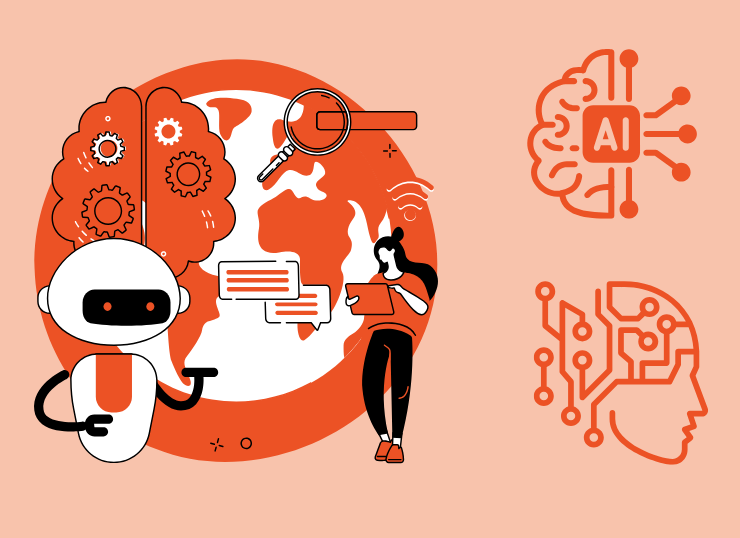Neuromorphic Computing: The Brain-Inspired Future of Artificial Intelligence
Artificial Intelligence (AI) has evolved from rule-based systems to deep learning models that power voice assistants, recommendation engines, and self-driving cars. Yet, despite their successes, today’s AI systems are still energy-hungry, limited in adaptability, and far from the efficiency of the human brain. This is where neuromorphic computing enters the conversation, a brain-inspired approach to AI that could shape the future of intelligent machines.
Neuromorphic computing seeks to replicate the architecture and processes of the human brain, bringing together neuroscience, computer engineering, and artificial intelligence. But what makes neuromorphic systems so revolutionary, and why are they considered the next step in AI evolution?

Ready to Transform Your Online Presence? Discover The Leading Digital Marketing Experts!
Supercharge your online business with Gandhi Technoweb Solutions’ remarkable digital marketing specialists! Explore top-of-the-line digital marketing strategies perfectly aligned with your budget.
What is Neuromorphic Computing?
Neuromorphic computing refers to brain-inspired hardware and software architectures designed to mimic how neurons and synapses function in biological systems. Unlike traditional computing, which relies on the von Neumann architecture (separating memory and processing), neuromorphic systems integrate both in a way that more closely resembles how the brain processes information.
Instead of relying on binary logic and sequential processing, neuromorphic computing uses:
- Spiking Neural Networks (SNNs): Modeled after the way biological neurons fire electrical impulses.
- Event-driven Processing: Computation happens only when needed, making it far more energy efficient.
- Parallelism: Multiple processes occur simultaneously, like in the brain.
Why Neuromorphic Computing Matters for AI?
The human brain is a marvel of efficiency, consuming just about 20 watts of power while handling complex cognitive functions. In comparison, modern AI models like GPT or computer vision systems require massive data centers and significant energy resources.
Neuromorphic computing aims to close this gap by:
- Reducing power consumption in AI models
- Improving adaptability in dynamic environments
- Enabling real-time learning with less data
- Supporting more human-like cognition
In short, neuromorphic systems could enable smarter, faster, and more energy-efficient AI applications.
How Neuromorphic Systems Work?
Traditional AI depends heavily on training large neural networks using vast datasets. Neuromorphic systems, however, attempt to model the actual workings of biological brains:
- Spiking Neurons – Information is transmitted as discrete “spikes” rather than continuous values, mimicking the firing of real neurons.
- Synaptic Plasticity – Just like biological synapses strengthen or weaken based on experience, neuromorphic systems adapt connections dynamically.
- On-Chip Learning – Instead of separating memory and computation, neuromorphic chips integrate them, enabling faster and more efficient processing.
- Event-Driven Architecture – Processing happens only when triggered by input, saving energy compared to constant computation.
Leading Neuromorphic Projects
Several global research initiatives and tech companies are investing heavily in neuromorphic computing:
- IBM TrueNorth: A neuromorphic chip with over one million programmable neurons and 256 million synapses.
- Intel Loihi: A chip designed with adaptive learning capabilities, supporting real-time problem solving.
- BrainScaleS (Heidelberg University): A European project replicating brain-like functions in hardware.
- SpiNNaker (University of Manchester): A system with over a million ARM processors designed to simulate large-scale brain activity.
These projects represent the beginning of scalable neuromorphic architectures that could transform industries.
Applications of Neuromorphic AI
The potential applications of neuromorphic computing extend across multiple industries:
1. Autonomous Systems
Self-driving cars, drones, and robots could benefit from neuromorphic chips that process sensory input in real time while consuming less energy.
2. Healthcare and Medical Devices
Neuromorphic AI could power brain-computer interfaces (BCIs), prosthetics, and diagnostic tools that adapt and learn from patient behavior.
3. Edge AI Devices
Neuromorphic processors could enable smartphones, IoT sensors, and wearables to run advanced AI without relying on cloud servers.
4. Cybersecurity
Adaptive neuromorphic systems could identify unusual patterns in real time, making them highly effective in preventing cyberattacks.
5. Industrial Automation
Factories could deploy neuromorphic systems for predictive maintenance, robotics, and real-time optimization with high efficiency.
Advantages of Neuromorphic Computing
- Energy Efficiency: Much lower power consumption compared to deep learning systems.
- Real-Time Adaptability: On-the-fly learning without massive retraining cycles.
- Closer to Human Cognition: Mimics brain-like processes, making AI more flexible.
- Scalability: Potential to build systems that simulate large-scale brain activity.
- Edge Deployment: Brings advanced AI capabilities to low-power devices.
Challenges of Neuromorphic Computing
Despite its promise, neuromorphic AI faces several challenges:
- Hardware Development: Creating chips that truly mimic neurons is still complex.
- Standardization Issues: No universal framework exists for neuromorphic architectures.
- Programming Complexity: Writing algorithms for spiking neural networks is difficult compared to traditional AI.
- Limited Industry Adoption: Neuromorphic chips are still experimental and not widely available.
- Scalability Concerns: Simulating full human brain-level intelligence remains far out of reach.
The Future of Brain-Inspired AI
Neuromorphic computing represents a bold step toward creating AI systems that think and adapt more like humans. While still in its early stages, the fusion of neuroscience and computer engineering could lead to breakthroughs in general intelligence, robotics, healthcare, and beyond.
In the coming decade, we may see neuromorphic chips integrated into consumer devices, powering everything from smartphones that learn your habits to robots that adapt in real time to their environments.
By closing the gap between artificial and biological intelligence, neuromorphic computing may unlock the brain-inspired future of AI that scientists and technologists have been striving toward for decades.

Elevate Your Local Presence: Partner with the Leading SEO Agency for Unmatched Visibility!
Stand out in local searches and outshine your competitors with our proven local SEO techniques, designed to put your business on the map.
Free SEO Audit from Gandhi Technoweb Solutions
Just as neuromorphic computing aims to make machines more adaptive and efficient, your website also requires constant optimization to perform at its peak. At Gandhi Technoweb Solutions, we provide a Free SEO Audit designed to uncover hidden issues that may be preventing your website from ranking higher in search engines. Our audit identifies technical SEO flaws, content opportunities, keyword gaps, and performance bottlenecks, giving you a clear roadmap for digital growth. Request your free SEO audit today and let our expert team help your website stay ahead in an ever-evolving digital landscape.








